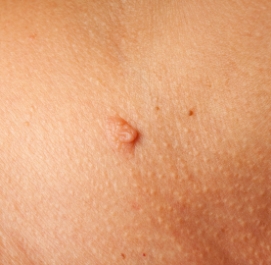What is a mole? We’ll tell you what these common skin growths are and let you know when you need to worry about one (most moles are harmless but sometimes they can be a sign of something serious). We’ll also tell you about ways to treat moles.
So What is a Mole?
Moles are common skin growths. They usually appear during childhood or adolescence but can develop during adulthood. When we say they are common, we mean very common. Most people have between 10 and 45 moles on their bodies (1).
Moles typically appear as small brown spots on the skin and may be flat or slightly raised. They are caused by clusters of pigmented cells. Most moles are harmless but there is a slight chance they can become cancerous.

When to See a Doctor
You should see a doctor if you notice irregularly shaped moles or moles that are asymmetrical. You should also see a doctor if you have a mole that seems to be growing or changing in shape. Note that it is not uncommon for moles to fade as you age and that is not a reason to worry. Moles that change color, though, maybe cause for concern, especially if part of the mole turns black in color. See a doctor if you have a mole that is painful or bleeds.
Ask your doctor if you have questions about what is a mole warning sign. If in doubt, consult your doctor.
In addition, moles in certain areas can easily become irritated. A mole on the wrist may catch on a watch or bracelet, for instance. A mole on the chin may accidentally be nicked when shaving. If moles become irritated and painful or bleed due to their location, they may need to be removed. Talk to your doctor if a mole is causing you any problems.
Even if your moles don’t show any warning signs or cause problems for you, you can see a doctor if you would like to have the mole removed. People often prefer to have moles removed, especially if they are in highly visible areas because they don’t like the way the moles look.
Of course, moles are only one type of skin growth. People sometimes have trouble differentiating between moles and other types of growths, such as warts, skin tags, and cherry angiomas. If you’re not sure what is a mole and what is another type of skin growth, don’t hesitate to see your doctor.
Typical Mole Treatment
Most moles don’t require any treatment. If there is a question about whether or not a mole might be malignant (cancerous), your doctor or dermatologist may do a biopsy, removing a small sample of the mole to test it.
If a mole needs to be removed, or if you simply prefer to have it removed, doctors usually remove moles by shaving them off your skin or by surgically excising them, which involves cutting them off and then suturing the resulting wound closed. Doctors numb the area around the mole with a local anesthetic first, similar to what dentists inject before drilling a cavity, but you may still feel some discomfort, especially after the anesthetic wears off.
Depending on the size of the mole and the method of treatment, as well as other factors, removing the mole may leave a scar. Complications of mole removal are uncommon but may include bleeding and infection. If a mole grows back after you’ve had it removed, see your doctor right away because this can be a warning sign.
We want to stress the fact that even if a mole is benign (non-cancerous) and does not need to be removed for medical reasons, concerns about appearance can be valid reasons for removing a mole. If you have a mole that makes you feel self-conscious or worried about your appearance, talk to your doctor about whether or not removing it would be beneficial to you.
Recommend Mole Removal Treatment
For removing the typical mole, we recommend a homeopathic treatment called H-Moles Formula. Made from natural ingredients including homeopathic remedies and essential oils and manufactured in the U.S.A., H-Moles Formula removes moles in as little as two weeks (larger moles may take longer to disappear completely). It’s available without a prescription and is easy to use at home. Just make sure you’re dealing with a common, benign mole before using H-Moles Formula. Consult your doctor if you’re not sure. To learn more about our favorite treatment for moles, just follow the link.
(1) Mayo Clinic – Moles




